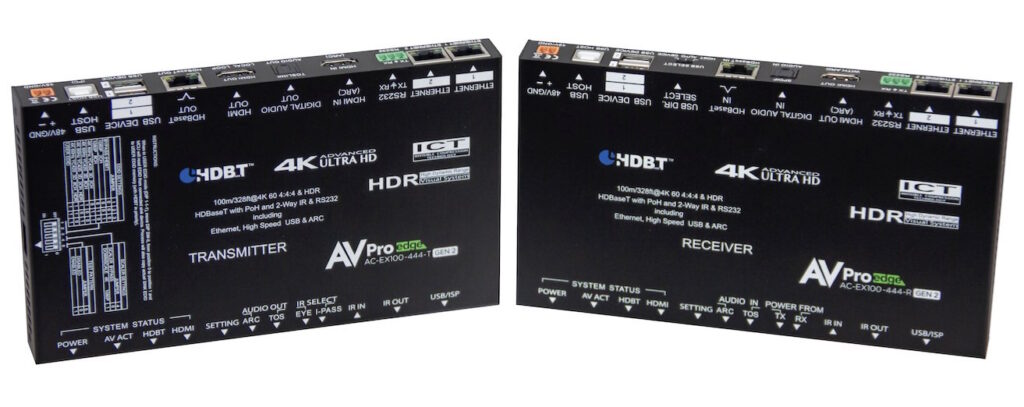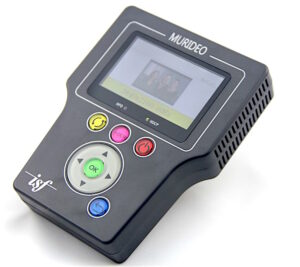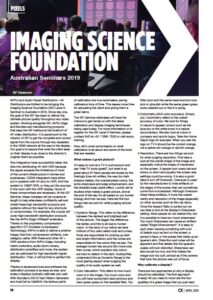News
24 Apr 2019
Imaging Science Foundation

Subscribe to CX E-News
PIXELS
Imaging Science Foundation
Australian Seminars 2019
AVPro and Audio Visual Distributors – AV Distributors are thrilled to be bringing the Imaging Science Foundation (ISF) Level III Seminar to Australia in 2019.
Since day one, the goal of the ISF has been to deliver the ultimate picture quality throughout any video system. Working alongside ISF, AVPro Edge and Murideo are manufacturing products that keep the ISF method at the forefront of 4K video distribution. It is paramount to the mission of ISF to get the complete and correct signal from the source through any repeaters in the HDMI network all the way to the display.
Our goal is to assure that what the client sees on their display is as close to the director’s original intent as possible.
Few integrators have successfully taken the dive into distributing 4K with HDR because the signal exceeds the limitations of most of the current infrastructure in homes and businesses. CEDIA integrators have either put in systems with 4K and no HDR, limit the system to 1080P SDR, or they put the sources in the room with the HDR display.
None of these compromises are necessary.
At the ISF Seminar, these missteps will be covered at length to help attendees confidently sell and install these high bandwidth products and systems without the need for any shortcuts or compromises.
For example, the course will cover high bandwidth distribution products like the AVPro Edge HDBaseT extenders. Thanks to the proprietary compression algorithm ICT (Invisible Compression Technology), AVPro is able to deliver a pristine image, free from compression artifacts, over category cable.
With these and other 4K + HDR solutions from AVPro Edge, including matrix switchers, audio down-mixers, distribution amplifiers and more, the system can be optimized for high bandwidth signal distribution. Then, it will be time to perfect the display.
Thanks to advanced tools and software the calibration process is as easy as ever, and today’s displays typically calibrate very well. With Murideo’s SIX-G Test Pattern Generator and AutoCal by CalMAN, the tedious parts of calibration are now automated, saving calibrators tons of time. This leaves more time for educating the client and giving them a great demo.
The ISF Seminar attendees will have the chance to get hands on with the latest calibration and display imaging techniques being used today.
For more information or to register for the ISF Level III Seminar, please contact AVD at +61 7 5561 7530 or visit avpro.training.
Now, let’s cover some basics on what calibration is all about and some of the tools that are needed.
What makes a great picture?
It’s easy to look at a TV in a showroom and say “that TV looks great!” but what is so great about it? Most people are fooled by the blaringly blue-ish whites, the way too dark shadow details, the oversaturated colours, the extra sharpness and edge enhancement, and the dreaded soap opera effect.
Luckily we’ve studied what makes a great picture, and at the end of the day it all based on our human biology and how we see. Here are the four things that we look for while judging picture quality:
1 Dynamic Range.
This refers to the difference between the darkest and brightest part of the picture. The bigger the difference the better, and this is all due to human vision. In the back of our retina we have millions of tiny cells called rods and cones. Rods are responsible for picking up dark and bright information, and the cones are responsible for the colours that we see.The average human has around 20x more rods than cones, which explains why colours are hard to detect in the dark. Audiophiles understand this as Dynamic Range is the most glaring aspect when judging the quality of an audio system as well.
2 Colour Saturation
This refers to how much colour is in the image. Too much colour and you will have sunburned news anchors and neon green grass on the baseball field. Too little colour and the same news anchors look sick or ghoulish while the same green grass looks washed out or like it is dying.
3 Colorimetry (AKA colour accuracy)
Simply put, Colorimetry refers to the overall accuracy of colour. We look for things in nature to appear correct such as the blue sky or the white snow in a nature documentary. We also look at colours in company and sports logos. Take the Home Depot logo for example. When you see the logo on TV it should be the correct orange, not a yellow-ish orange or red-ish orange.
4 Resolution
There are two things we look for when judging resolution. First take a look at the overall shape of the image and especially notice the shape of characters on the screen. If people look overly tall and skinny or short and squatty the screen size settings could be wrong. It is also a good idea to turn off Overscan.
Overscan is used by the manufacturers to hide artifacts on the edges of the screen that can sometimes come from a broadcast. Although Overscan hides these artifacts, it hurts the overall clarity and resolution of the image especially on other sources such as Blu-ray discs.
Once the Aspect Ratio is sorted out we can take a look at the display’s Sharpness setting. Most people do not realize this, but it is possible to have too much sharpness! Too much Sharpness can cause an artifact called “Edge Enhancement”. It is easy to spot when viewing something with a lot of details such as text on the screen, a person’s face, or the scales that make up an iguana’s skin.
Distortion and noise will be apparent and fine details like the iguana’s scales will look distorted. Sharpness can also be set too low, and this makes the image look too soft, almost as if the camera that took the picture was out of focus.
Why calibrate a display?
There are two approaches to why a display should be calibrated. The first approach is easy! All you need to know are the four qualities of a great image that you just read about. Let’s use these and talk about how the picture will be improved after calibration.
1 Dynamic Range – When Dynamic Range is set correctly, you will have the most amount of detail in the brightest and darkest parts of the picture. This means things like scary shadows in a dark horror movie or the fur on a polar bear’s face and everything in between will be visible.
2 Colour Saturation – The display will have the right amount of colour. Things like flowers, food, grass, sports fields, and especially skin tones will look natural
3 Colorimetry – Things that you are familiar with in real life will be the appropriate colour. The ice will be white for hockey fans and jersey colours and other logos will be correct.
4 Resolution – The image will be as clear as it can be while seeing as many details as possible, and people on the screen will appear to be the appropriate shape and size.
The second approach is all about standards, which can be somewhat abstract to the average Joe. When we calibrate a display we are setting it to known standards. There is a major benefit to this because it will allow you to view the movie, video game, TV show, etc as the creators intended.
Calibration is all about honouring the art of content creation. When a filmmaker uses a specific colour palette for a scene of a movie, it is done intentionally. Colour in movies is used to set the mood of a scene and to evoke emotion within the viewer. This type of emotional manipulation is not only used in film, but video games and TV shows as well.
As someone who appreciates the time, effort, and artistry that goes into production, calibration ensures that the reproduction is as close as possible to what was intended.
Now that we have defined picture quality and covered the benefits of display calibration, let’s cover what tools are needed to offer this unique service.
What tools are needed?
1 Test Pattern Generator
This tool is responsible for putting test patterns on the display. Test patterns are used throughout the calibration process to verify a variety of things like black level, white level, colour, resolution, and more. There are a few things to look for when shopping for a pattern generator such as portability, size, and functionality.
The Murideo SIX-G is a go to as it is 4k and HDR/Dolby Vision compliant, has a rechargeable battery, is small and portable, and field upgradeable. You can also use it for troubleshooting purposes and to test HDMI cables if paired up with the Murideo SIX-A signal analyzer.
2 Light Meter
This tool will read the light and colour of light that comes from the display that you are calibrating. There are many different makes, models, and prices of light meters, and each one serves a specific purpose. When shopping for a light meter, consider its portability, size, and speed.
 There are two types of light meters; tristimulus and spectral, and the one you pick depends on your budget and how fast or accurate you need the calibration to be. Tristimulus devices are known for their speed while spectral devices are known for accuracy.
There are two types of light meters; tristimulus and spectral, and the one you pick depends on your budget and how fast or accurate you need the calibration to be. Tristimulus devices are known for their speed while spectral devices are known for accuracy.
A lot of calibrators use both by using one to profile the other. Profiling two meters ensures the accuracy of the spectral meter but gives you the speed of the tristimulus meter.
3 Software
There are a variety of software packages available to drive the calibration with prices ranging from free to thousands of dollars. I personally use CalMAN, but there are others such as Light Illusion, HCFR, DisplayCal, and more.
I prefer CalMAN for multiple reasons; such as, its intuitive workflows, compatibility with a variety of different light meters and test pattern generators, and a relatively new feature call AutoCal. AutoCal allows CalMAN to take control of the display and automates the tedious and time consuming steps such as grayscale and colour gamut adjustments.
This is a huge time saver and will help you get through a calibration efficiently without any sacrifice to accuracy.
4 Infrastructure
Today’s video signals are passed though many products that can have an effect on the picture you see. In order to distribute a solid 4K, 18Gbps signal, you need products developed to pass this kind of signal. Most products being developed today are not able to meet this data rate.
AVPro Edge has developed a line of video distribution products built to handle high bandwidth 4K. When you need to extend, switch, split, scale or downmix; AVPro Edge products will help you get the job done.
ISF Calibration is a very unique, custom service that you should be offering to your clients. Labour dollars will contribute to your bottom line and system maintenance will not only ensure that your client’s system is performing it’s best, but it will also bring in recurring revenue.
We have studied the numbers over the years and have also found out that ISF calibration also helps prevent TV returns which is a great added bonus. With the help of AVPro and the ISF, we can give you knowledge to not only perform this service, but also how to explain the benefits to your salespeople and ultimately your clients.
Again, for more information including dates for ISF Australia and other AVPro Academy classes, contact AV Distributors at www.avdistributors.com.au or +61 7 5561 7530 or visit www.avpro.training
- ISF Classroom
- ISF Classroom
From CX Magazine – April 2019
CX Magazine is Australia and New Zealand’s only publication dedicated to entertainment technology news and issues – available in print and online. Read all editions for free or search our archive www.cxnetwork.com.au
© CX Media
Subscribe
Published monthly since 1991, our famous AV industry magazine is free for download or pay for print. Subscribers also receive CX News, our free weekly email with the latest industry news and jobs.









